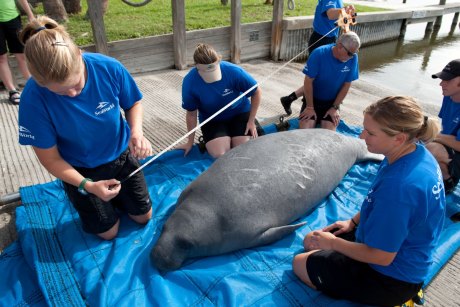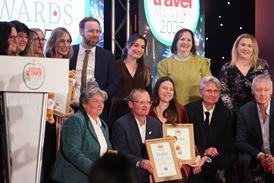.jpg)
Find out how pupils from Barry Island Primary School got on when they took a school trip to Florida.
School: Barry Island Primary School, Vale of Glamorgan, Wales
Subject: STEM
KS: 2
Number of pupils: 14
Space, skydiving and SeaWorld were all part of an unforgettable STEM trip to the Sunshine State that left a group of pupils eager to learn more.
It was a giant step for Barry Island Primary School and two other local schools, as none had embarked on such an ambitious trip before. However, following 15 months of planning, sponsorship and preparation in the classroom, the inspirational seven-day visit to Florida was a textbook example of how overseas trips can expand horizons in every sense of the word.
Barry Island Primary School partnered with two other local primary schools, St Joseph’s Roman Catholic and Evenlode, and ten Year 6 pupils from Barry Island went on the trip with four ten and 11-year-olds from these schools. The transatlantic trip came about after they were introduced to the International Space School Educational Trust (ISSET), a registered UK charity that utilises space exploration and science to inspire and motivate young people of all ages.
Acting deputy headteacher Dominic Broad said: “The idea for a group of Primary schools to go on a trip originally came from Gareth Rein, headteacher at St Joseph’s, who invited the schools to explore the idea of such a trip further. ISSET organised the trip in consultation with the schools. We held a parents meeting with ISSET, who outlined the trip and generated interest, and we received sponsorship from Cornerstones, Scholastic and 5 A-Day to subsidise the trip. It was open to all pupils at the school, but it was primarily a STEM focused trip so this naturally attracted children that were interested in Technology and Science.
“The purpose was to show the children how STEM can be applied to real life and to showcase careers in the sciences in action, including biology and zoology, as well as to raise aspirations and provide children with exciting and once in a lifetime experiences.
“We wanted to raise the profile of STEM amongst the children and give them an opportunity they wouldn’t usually have. At Barry Island Primary School we try to create as many exciting learning opportunities as possible as we believe positive and inspiring learning makes the children excited about coming to school and makes them want to learn. That’s what teaching is all about, creating opportunities and harnessing the children’s enthusiasm.”
There was certainly plenty of excitement in the lead-up to the trip as the pupils from the three schools met regularly to complete a range of STEM-themed research and activities.
“In one session we created stop motion animation, in another we designed a healthy space snack and packaging,” explained Dominic. “Each activity was designed to encourage team work amongst the group set to travel. In Science our topic was habitats. We explored the habitats of the marine animals we were going to see at SeaWorld, like manatees and turtles, and where they come from.

Pictured: SeaWorld workers prepare a manatee for being released back into the wild.
“The final project was designing the mission badge, similar to the project astronauts completed before the Apollo missions. The children designed a badge and made a video explaining it which was posted on their Hwb blog page. Hwb is a digital learning platform in Wales where children can write their own blog posts, share work, access learning resources and safely and securely contact teachers and other learners to extend the learning opportunities outside the classroom.”
Children across the schools voted on the badge and the winning design was attached to the group’s luggage, which added to the experience of visiting NASA. Finally it was time for blast off, and the pupils were accompanied by former acting headteacher Becky Cadman who played a key role in the organisation of the trip, two other teachers and two ISSET representatives.
The itinerary featured a day at Kennedy Space Center, exploring the garden that is home to rockets used by NASA, and a ride in the Atlantis space shuttle simulator. The next day the pupils learned the physics behind the thrilling iFly indoor skydiving facility, before trying it for themselves.
Day four was spent at SeaWorld, including front row (and very wet!) seats at the killer whale show and a behind the scenes tour to learn about SeaWorld’s conservation work and how its team of vets treat and rehabilitate injured marine life.
Talking about the educational highlights, Dominic said: “The children were able to participate in Physics lectures at iFly. This allowed them to understand the forces acting on their body in the wind tunnel and relate them to the forces acting on a rocket at take-off. At SeaWorld the children were able to see X-rays of alligators and ultrasounds of dolphins. The education team were very enthusiastic and taught them about the variety of species in the park and the importance of protecting their habitats.”
He said the high spot for pupils, quite literally, was the indoor skydiving experience.
“They also enjoyed visiting a sick manatee, which had been fitted with a custom made lifejacket to help it stay afloat, and its baby in the medical centre at SeaWorld,” he added. “The manatee was later featured in the children’s newspaper First News, so they were able to complete a written task around their experiences using the article. The Shamu killer whale show was also very popular, and was also educational.”

Pictured: Pupils study the x-ray of an alligator behind the scenes at SeaWorld.
Some of the children also ended up in the limelight, with one budding marine biologist being interviewed during the show. On return the trip was featured on the ITV news and in local newspapers.
Summing up Dominic said: “It was the first trip of this kind for the schools involved, however following the success of the trip the schools will be considering similar ones in the future. We have received amazing feedback from the pupils and their parents. A lot them have said to us that they’re all set for a career in science now, which is what we hoped for.
“There is a real buzz around STEM at the moment and Barry Island Primary School will be using this enthusiasm to raise the profile of our STEM club and continue to move STEM forward across the curriculum.
Back in the classroom
“Once back in class, the children were very keen to continue the collaborative projects we had participated in prior to the trip,” said Dominic. “We decided to plan out a mini Design Technology project for Design Technology Week to develop and create an example of what the Mars colony might look like if the mission were to go ahead. Children were encouraged to use numeracy skills in a variety of challenging situations and consider the many variables that could impact on the facility, from sustainable produce to quarantine for illnesses.
“We used our Science topic, habitats, to look at the range of animals and marine life we met in SeaWorld. We also looked at global warming and what that would mean to certain habitats, based on the lessons we had in the park’s education centre. The children then submitted their proposals and presentations as a blog on their Hwb page.”
To contact the International Space School Educational Trust call 02920-710295 or visit www.isset.org.










